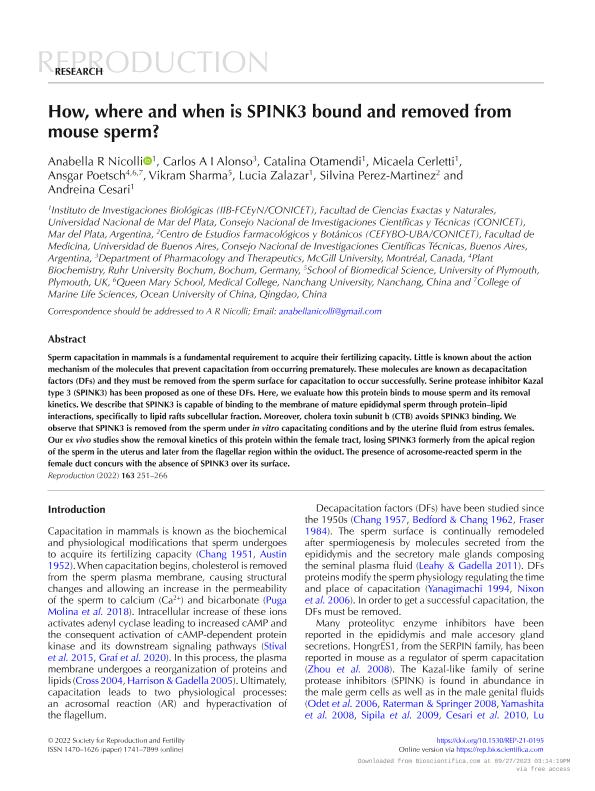Artículo
How, where and when is SPINK3 bound and removed from mouse sperm?
Nicolli, Anabella Rita ; Alonso, Carlos A. I.; Otamendi, Catalina; Cerletti, Micaela
; Alonso, Carlos A. I.; Otamendi, Catalina; Cerletti, Micaela ; Poetsch, Ansgar; Sharma, Vikram; Zalazar, Lucia
; Poetsch, Ansgar; Sharma, Vikram; Zalazar, Lucia ; Perez Martinez, Silvina Laura
; Perez Martinez, Silvina Laura ; Cesari, Andreina
; Cesari, Andreina
 ; Alonso, Carlos A. I.; Otamendi, Catalina; Cerletti, Micaela
; Alonso, Carlos A. I.; Otamendi, Catalina; Cerletti, Micaela ; Poetsch, Ansgar; Sharma, Vikram; Zalazar, Lucia
; Poetsch, Ansgar; Sharma, Vikram; Zalazar, Lucia ; Perez Martinez, Silvina Laura
; Perez Martinez, Silvina Laura ; Cesari, Andreina
; Cesari, Andreina
Fecha de publicación:
02/2022
Editorial:
BioScientifica
Revista:
Reproduction
ISSN:
1470-1626
Idioma:
Inglés
Tipo de recurso:
Artículo publicado
Clasificación temática:
Resumen
Sperm capacitation in mammals is a fundamental requirement to acquire their fertilizing capacity. Little is known about the action mechanism of the molecules that prevent capacitation from occurring prematurely. These molecules are known as decapacitation factors (DFs) and they must be removed from the sperm surface for capacitation to occur successfully. Serine protease inhibitor Kazal type 3 (SPINK3) has been proposed as one of these DFs. Here, we evaluate how this protein binds to mouse sperm and its removal kinetics. We describe that SPINK3 is capable of binding to the membrane of mature epididymal sperm through protein-lipid interactions, specifically to lipid rafts subcellular fraction. Moreover, cholera toxin subunit b (CTB) avoids SPINK3 binding. We observe that SPINK3 is removed from the sperm under in vitro capacitating conditions and by the uterine fluid from estrus females. Our ex vivo studies show the removal kinetics of this protein within the female tract, losing SPINK3 formerly from the apical region of the sperm in the uterus and later from the flagellar region within the oviduct. The presence of acrosome-reacted sperm in the female duct concurs with the absence of SPINK3 over its surface.
Archivos asociados
Licencia
Identificadores
Colecciones
Articulos(CEFYBO)
Articulos de CENTRO DE ESTUDIOS FARMACOLOGICOS Y BOTANICOS
Articulos de CENTRO DE ESTUDIOS FARMACOLOGICOS Y BOTANICOS
Articulos(IIB)
Articulos de INSTITUTO DE INVESTIGACIONES BIOLOGICAS
Articulos de INSTITUTO DE INVESTIGACIONES BIOLOGICAS
Citación
Nicolli, Anabella Rita; Alonso, Carlos A. I.; Otamendi, Catalina; Cerletti, Micaela; Poetsch, Ansgar; et al.; How, where and when is SPINK3 bound and removed from mouse sperm?; BioScientifica; Reproduction; 163; 5; 2-2022; 251-266
Compartir
Altmétricas



